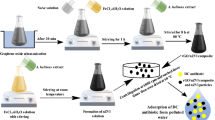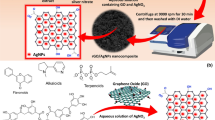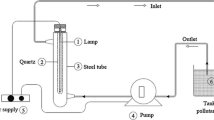Abstract
In this paper, reduced graphenoxide/attapulgite (rGO/APT)-supported nanoscale zero-valent iron (nZVI) composites (rGO/APT-nZVI) were synthesized to remove acid red 18 (AR18) and other organic dyes from aqueous solutions. The structure of synthetic rGO/APT-nZVI composite was characterized by Fourier transform infrared spectroscopy (FT-IR), scanning electron microscope (SEM), transmission electron microscope (TEM), and X-ray diffraction (XRD), and the removal properties of rGO/APT-nZVI on AR18 were investigated. The factors of various experimental parameters (ratio, pH, initial concentration, temperature, and time) impacting on removal of AR18 were studied as well. Comparison experiment of different materials showed that 93.5% of AR18 was removed using rGO/APT-nZVI, while only 7.9% and 64.8% of AR18 were removed using rGO/APT-nZVI after reacting for 30 min with an initial AR18 concentration of 100 mg L−1, respectively. Moreover, kinetic and thermodynamic analyses were used to study the reduction process, and possible mechanism of AR18 removal was discussed. The results show that the rGO/APT-nZVI composites can effectively degrade AR18 over a wide range of pH and keep degradation activity in a long storage. In addition, the superior behaviors for other organic dyes removal highlight the great potential as an efficient adsorbent for water pollution.















Similar content being viewed by others
References
Chandrasekaran, S., Hur, S. H., Kim, E. J., Rajagopalan, B., Babu, K. F., Senthilkumar, V., Chung, J. S., Choi, W. M., & Kim, Y. S. (2015). Highly-ordered maghemite/reduced graphene oxide nanocomposites for high-performance photoelectrochemical water splitting. RSC Advances, 5(37), 29159–29166.
Chen, Z., Jin, X., Chen, Z., Megharaj, M., & Naidu, R. (2011a). Removal of methyl orange from aqueous solution using bentonite-supported nanoscale zero-valent iron. Journal of Colloid & Interface Science, 363(2), 601–607.
Chen, H., Zhao, J., Wu, J., & Dai, G. (2011b). Isotherm, thermodynamic, kinetics and adsorption mechanism studies of methyl orange by surfactant modified silkworm exuviae. Journal of Hazardous Materials, 192(1), 246–254.
Chen, Z., Wang, T., Jin, X., Chen, Z., Megharaj, M., & Naidu, R. (2013). Multifunctional kaolinite-supported nanoscale zero-valent iron used for the adsorption and degradation of crystal violet in aqueous solution. Journal of Colloid & Interface Science, 398(19), 59–66.
Cheng, R., Ou, S., Xiang, B., Li, Y., & Liao, Q. (2010). Equilibrium and molecular mechanism of anionic dyes adsorption onto copper(II) complex of dithiocarbamate-modified starch. Langmuir, 26(2), 752–758.
Choe, S., Chang, Y. Y., Hwang, K. Y., & Khim, J. (2000). Kinetics of reductive denitrification by nanoscale zero-valent iron. Chemosphere, 41(8), 1307–1311.
Fan, H., Wang, H., Zhao, N., Zhang, X., & Xu, J. (2011). Hierarchical nanocomposite of polyaniline nanorods grown on the surface of carbon nanotubes for high-performance supercapacitor electrode. Journal of Materials Chemistry, 22(6), 2774–2780.
Fan, S., Tang, J., Wang, Y., Li, H., Zhang, H., Tang, J., Wang, Z., & Li, X. (2016). Biochar prepared from co-pyrolysis of municipal sewage sludge and tea waste for the adsorption of methylene blue from aqueous solutions: Kinetics, isotherm, thermodynamic and mechanism. Journal of Molecular Liquids, 220, 432–441.
Fu, F., Dionysiou, D. D., & Liu, H. (2014). The use of zero-valent iron for groundwater remediation and wastewater treatment: a review. Journal of Hazardous Materials, 267(3), 194–205.
Fu, R., Yang, Y., Xu, Z., Zhang, X., Guo, X., & Bi, D. (2015). The removal of chromium (VI) and lead (II) from groundwater using sepiolite-supported nanoscale zero-valent iron (S-NZVI). Chemosphere, 138, 726–734.
Gao, Q., Zhu, H., Luo, W., Wang, S., & Zhou, C. (2014). Preparation, characterization, and adsorption evaluation of chitosan-functionalized mesoporous composites. Microporous and Mesoporous Materials, 193(3), 15–26.
Garg, V. K., Gupta, R., Yadav, A. B., & Kumar, R. (2003). Dye removal from aqueous solution by adsorption on treated sawdust. Bioresource Technology, 89(2), 121–124.
Gupta, K., & Khatri, O. P. (2017). Reduced graphene oxide as an effective adsorbent for removal of malachite green dye: Plausible adsorption pathways. Journal of Colloid & Interface Science, 501, 11–21.
Hao, J., Ji, L., Li, C., Hu, C., & Wu, K. (2018). Rapid, efficient and economic removal of organic dyes and heavy metals from wastewater by zinc-induced in-situ reduction and precipitation of graphene oxide. Journal of the Taiwan Institute of Chemical Engineers, 88, 137–145.
Heibati, B., Rodriguez-Couto, S., Al-Ghouti, M. A., Asif, M., Tyagi, I., Agarwal, S., & Gupta, V. K. (2015). Kinetics and thermodynamics of enhanced adsorption of the dye AR 18 using activated carbons prepared from walnut and poplar woods. Journal of Molecular Liquids, 208, 99–105.
Jabeen, H., Chandra, V., Jung, S., Lee, J. W., Kim, K. S., & Kim, S. B. (2011). Enhanced Cr(vi) removal using iron nanoparticle decorated graphene. Nanoscale, 3(9), 3583–3585.
Jin, X., Chen, Z., Zhou, R., & Chen, Z. (2015). Synthesis of kaolin supported nanoscale zero-valent iron and its degradation mechanism of direct fast black G in aqueous solution. Materials Research Bulletin, 61, 433–438.
Li, Y., Du, Q., Liu, T., Peng, X., Wang, J., Sun, J., Wang, Y., Wu, S., Wang, Z., Xia, Y., & Xia, L. (2013). Comparative study of methylene blue dye adsorption onto activated carbon, graphene oxide, and carbon nanotubes. Chemical Engineering Research & Design, 91(2), 361–368.
Li, Z., Wang, L., Yuan, L., Xiao, C., Mei, L., & Zheng, L. (2015). Efficient removal of uranium from aqueous solution by zero-valent iron nanoparticle and its graphene composite. Journal of Hazardous Materials, 290, 26–33.
Li, J., Chen, C., Zhu, K., & Wang, X. (2016). Nanoscale zero-valent iron particles modified on reduced graphene oxides using a plasma technique for Cd(II) removal. Journal of the Taiwan Institute of Chemical Engineers, 59, 389–394.
Mahmoodi, N. M., Maroofi, S. M., Mazarji, M., & Nabi-Bidhendi, G. (2017). Preparation of modified reduced graphene oxide nanosheet with cationic surfactant and its dye adsorption ability from colored wastewater. Journal of Surfactants & Detergents, 20(5), 1085–1093.
Mercante, L. A., Facure, M. H. M., Locilento, D. A., Sanfelice, R. C., Migliorini, F. L., Mattoso, L. H. C., & Correa, D. S. (2017). Solution blow spun PMMA nanofibers wrapped with reduced graphene oxide as an efficient dye adsorbent. New Journal of Chemistry, 41(17), 9087–9094.
Mu, B., & Wang, A. Q. (2015). One-pot fabrication of multifunctional superparamagnetic attapulgite/Fe3O4/polyaniline nanocomposites served as an adsorbent and catalyst support. Journal of Materials Chemistry A, 3(1), 281–289.
Mu, B., & Wang, A. Q. (2016). Adsorption of dyes onto palygorskite and its composites: a review. Journal of Environmental Chemical Engineering, 4(1), 1274–1294.
Park, H., & Choi, W. (2003). Visible light and Fe(III)-mediated degradation of acid Orange 7 in the absence of H2O2. Journal of Photochemistry & Photobiology A Chemistry, 159(3), 241–247.
Quan, G., Sun, W., Yan, J., & Lan, Y. (2014). Nanoscale zero-zalent iron supported on biochar: characterization and reactivity for degradation of acid orange 7 from aqueous solution. Water, Air, & Soil Pollution, 225, 2195.
Reck, I. M., Paixao, R. M., Bergamasco, R., Vieira, M. F., & Vieira, A. M. S. (2018). Removal of tartrazine from aqueous solutions using adsorbents based on activated carbon and Moringa oleifera seeds. Journal of Cleaner Production, 171, 85–97.
Rhouta, B., Zatile, E., Bouna, L., Lakbita, O., Maury, F., Daoudi, L., Lafont, M. C., Amjoud, M. B., Senocq, F., & Jada, A. (2013). Comprehensive physicochemical study of dioctahedral palygorskite-rich clay from Marrakech High Atlas (Morocco). Physics & Chemistry of Minerals, 40(5), 411–424.
Robinson, T., McMullan, G., Marchant, R., & Nigam, P. (2001). Remediation of dyes in textile effluent: A critical review on current treatment technologies with a proposed alternative. Bioresource Technology, 77(3), 247–255.
Shaibu, S., Adekola, F., Adegoke, H., & Ayanda, O. (2014). A comparative study of the adsorption of methylene blue onto synthesized nanoscale zero-valent iron-bamboo and manganese-bamboo composites. Materials, 7(6), 4493–4507.
Shi, L., Zhang, X., & Chen, Z. (2011). Removal of chromium (VI) from wastewater using bentonite-supported nanoscale zero-valent iron. Water Research, 45(2), 886–892.
Shirmardi, M., Mesdaghinia, A., Mahvi, A. H., Nasseri, S., & Nabizadeh, R. (2012). Kinetics and equilibrium studies on adsorption of acid red 18 (azo-dye) using multiwall carbon nanotubes (MWCNTs) from aqueous solution. E-Journal of Chemistry, 9(4), 2371–2383.
Sun, Z., Zheng, S., Ayoko, G. A., Frost, R. L., & Xi, Y. (2013). Degradation of simazine from aqueous solutions by diatomite-supported nanoscale zero-valent iron composite. Journal of Hazardous Materials, 263, 768–777.
Uzum, C., Shahwan, T., Eroglu, A. E., Hallam, K. R., Scott, T. B., & Lieberwirth, I. (2009). Synthesis and characterization of kaolinite-supported zero-valent iron nanoparticles and their application for the removal of aqueous Cu2+ and Co2+ ions. Applied Clay Science, 43(2), 172–181.
Wang, W., & Wang, A. (2016). Recent progress in dispersion of palygorskite crystal bundles for nanocomposites. Applied Clay Science, 119, 18–30.
Wang, C., Luo, H., Zhang, Z., Wu, Y., Zhang, J., & Chen, S. (2014). Removal of As(III) and As(V) from aqueous solutions using nanoscale zero valent iron-reduced graphite oxide modified composites. Journal of Hazardous Materials, 268(3), 124–131.
Wang, L., Chen, Z., Wen, H., Cai, Z., He, C., Wang, Z., & Yan, W. (2018). Microwave assisted modification of activated carbons by organic acid ammoniums activation for enhanced adsorption of acid red 18. Powder Technology, 323, 230–237.
Wu, X., Zhu, W., Zhang, X., Chen, T., & Frost, R. L. (2011). Catalytic deposition of nanocarbon onto palygorskite and its adsorption of phenol. Applied Clay Science, 52(4), 400–406.
Yang, B., Tian, Z., Zhang, L., Guo, Y., & Yan, S. (2015). Enhanced heterogeneous Fenton degradation of methylene blue by nanoscale zero valent iron (nZVI) assembled on magnetic Fe3O4/reduced graphene oxide. Journal of Water Process Engineering, 5, 101–111.
Funding
This work was supported by the National Natural Science Foundation of China (NSFC) (51763015, 51503092), the Foundation of Key Laboratory of Clay Mineral Applied Research of Gansu Province, Lanzhou Institute of Chemical Physics, Chinese Academy of Sciences (CMAR-04), and the Foundation for Innovation Groups of Basic Research in Gansu Province (No. 1606RJIA322).
Author information
Authors and Affiliations
Corresponding authors
Ethics declarations
Conflict of Interest
The authors declare that they have no conflicts of interest.
Additional information
Publisher’s Note
Springer Nature remains neutral with regard to jurisdictional claims in published maps and institutional affiliations.
Rights and permissions
About this article
Cite this article
Xu, H., Tian, W., Zhang, Y. et al. Reduced Graphene Oxide/Attapulgite-Supported Nanoscale Zero-Valent Iron Removal of Acid Red 18 from Aqueous Solution. Water Air Soil Pollut 229, 388 (2018). https://doi.org/10.1007/s11270-018-4033-5
Received:
Accepted:
Published:
DOI: https://doi.org/10.1007/s11270-018-4033-5




